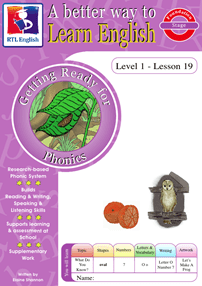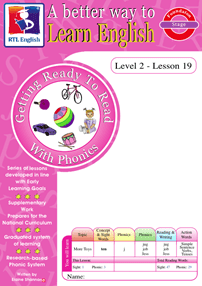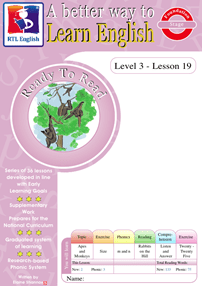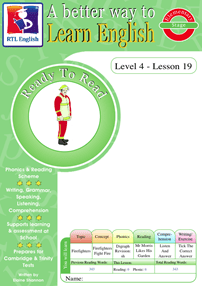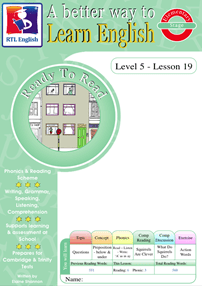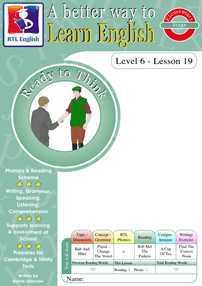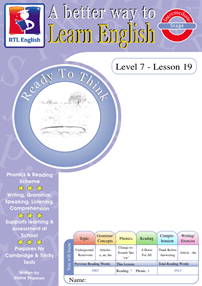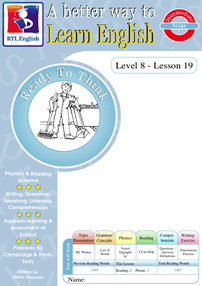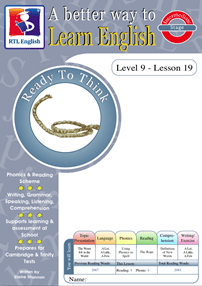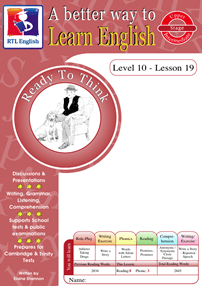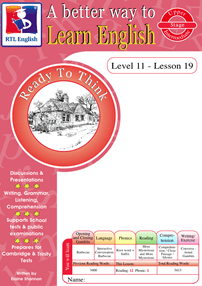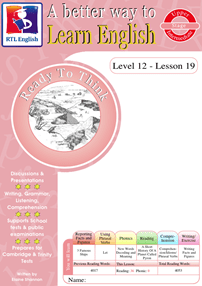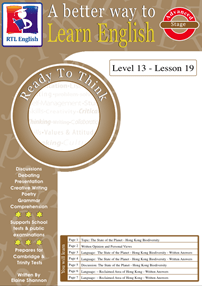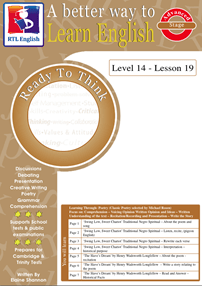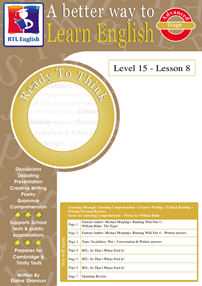English lessons for kids in Albuquerque, New Mexico

For over 20 years, RTL English has been taught in schools, tutorial centres & at home both as part of the curriculum and as a supplementary activity. RTL English is growing in popularity worldwide, so why not join tens of thousands of parents, tutors & teachers around the world & teach your son or daughter RTL English today?
Teaching your son or daughter to use English confidently might very well be the key to their success at school in New Mexico, in exams, in his or her career and beyond.
Teaching English to your child might be the key, not only to his or her success in school in Albuquerque, but also their sense of self-worth, both in New Mexico and beyond.
Elaine Shannon, Author & Curriculum Designer Tweet
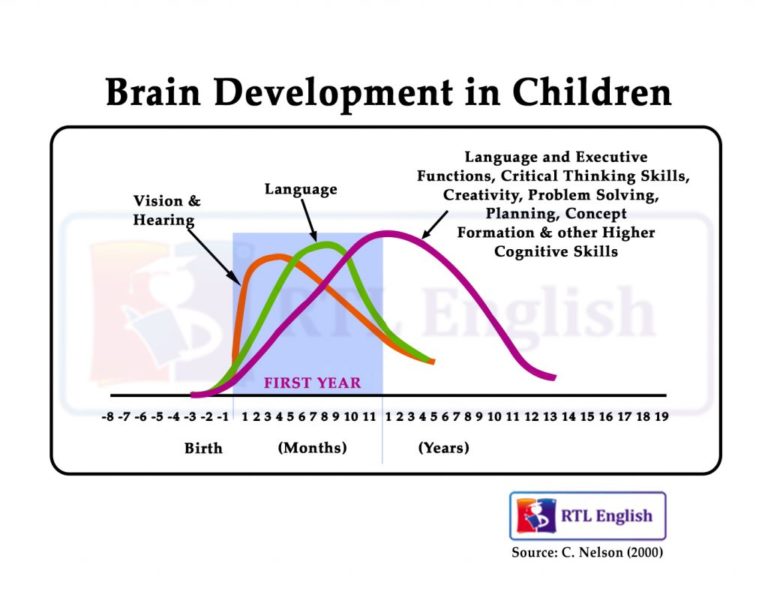
- Early & advanced English skills will make your child smarter.
- Early & advanced English skills will improve problem solving.
- Early & advanced English skills will improve planning, and abstract thinking skills.
- Early & advanced English skills will help develop complex idea comprehension.
- Early reading can help children compensate for modest levels of ability in other areas. (*Ref)
ON A PRACTICAL LEVEL, HOW IMPORTANT IS EARLY READING?
- Your son or daughter’s reading ability & vocabulary at 3 years old might predict his or her success in school in Albuquerque when they are 6 to 7 years old (*Ref).
- Your child’s reading ability at 6 to 7 years old might predict his or her success at 17 to 18 years old (*Ref)!
- Your child’s reading ability at 7 to 8 years old might determine their graduation from senior school in Albuquerque (*Ref).
ON THE OTHER HAND:
- Children who can’t read proficiently by 7 to 8 years old are four times more likely to leave school without a diploma/results than proficient readers (*Ref).
and:
- Children who are not taught Phonemic Awareness, & therefore have to rely on memory have difficulty beginning to read & continue to have difficulty with new words.
BUT, SURELY SCHOOL WILL TEACH MY CHILD TO READ? SO, WHY DO I NEED TO BOTHER?
If this is what you are thinking, then you should know that you cannot rely on schools, including those in Albuquerque …
- In the USA, almost 70% of children at school who are aged 9-10 years old cannot read proficiently (*Ref)!
- And, of those children, 33% of them read at only a very basic level, and 34% are reading at a very unsatisfactory level (*Ref).
- It’s not very different in the UK, where over 100,000 children leave school illiterate(*Ref).
- Or in Australia, where 33% of students aged 11 years old fail to meet literacy benchmarks (*Ref).
- Or in Canada, where 42% of the entire adult population is only semi-illiterate (*Ref).
NO, YOU CANNOT RELY ON SCHOOLS.
But, why not?
- Teachers don’t always understand the basic building blocks of language and reading
- Teachers frequently don’t know how to teach English language concepts
- There just aren’t enough qualified teachers
- Classes are too big
- Kids don’t get enough attention from teachers in the classroom
- Schools aren’t using the correct teaching systems – i.e they rely on rote learning or sight words
- Schools are overwhelmed and have tried to shift some of the burden of teaching onto apps and computers
UNFORTUNATELY, IT IS A FACT THAT:
Being illiterate is a guaranteed ticket to a dead end.
YOU NEED TO TAKE CHARGE OF YOUR CHILD’S EDUCATION – TODAY!
BUT HOW?
You can begin by teaching English to your child.
By Teaching your child to read your child will develop early reading skills that will help put them years ahead of other children in New Mexico. So, if you’ve decided that you want to become a proud parent of a happy and smart child, then you owe it to your son or daughter to teach them to read and improve their English.
WE HELP PARENTS TEACH ENGLISH TO CHILDREN
RTL English™ offers 600 easy-to-teach & downloadable English lessons for parents to teach to his or her child at home. Our workbook lessons will help your child to catch up, keep up & stay ahead! Our workbook lessons also challenge more advanced students; so whatever your son or daughter’s ability, there’s sure to be an RTL English lesson workbook that’s suitable for them.
THE RTL ENGLISH CURRICULUM CONSISTS OF FIFTEEN YEARS (LEVELS) OF TEACHING MATERIALS WHICH INCLUDE SIX HUNDRED LESSON WORKBOOKS COMPRISED OF FOUR THOUSAND WORKSHEETS & 19,000 TEACHING NOTES AND WILL SAVE YOU OVER 2,000 DAYS OF LESSON PREPARATION TIME!
Foundation Stage
Includes Level 1, 2 & 3.
Suitable for kids aged 3-6 years old in Albuquerque, New Mexico
Elementary Stage
Includes Level 4, 5 & 6.
Suitable for kids aged 6-9 years old in Albuquerque, New Mexico
Intermediate Stage
Includes Level 7, 8 & 9.
Suitable for kids aged 9-12 years old in Albuquerque, New Mexico
Upper Intermediate Stage
Includes Level 10, 11 & 12.
Suitable for kids aged 12-15 years old in Albuquerque, New Mexico
Advanced Stage
Incl. Level 10, 11 & 12.
Suitable for kids aged 15-18 years old in Albuquerque, New Mexico
Winning Awards Since 1996
With 24 years of research, development, dedication and experience, RTL English is committed to offering the best possible start to English language learners worldwide. RTL English is part of the Ready To Learn group, an international educational organisation with students worldwide.
Elaine Shannon founded Ready To Learn in 1996, and is an internationally respected author, language expert and School Principal with more than 40 years of specialist experience. Elaine & her team of instructional designers, linguists and educational experts developed the RTL English Curriculum.
What Happens In A Lesson?
- Each lesson is designed to last approximately 60 minutes. Normally, your child will spend 55 minutes participating in learning activities, and 5 minutes completing an achievement exercise that’s used to reinforce the lessons’ learning designs & objectives.
- Each lesson is accompanied by an RTL English lesson workbook. The workbook consists of six worksheets of instructional content and one reinforcement exercise page.
- You will use the workbook & teaching notes to guide and lead your child through the variety of learning activities in the workbook.
- Although all of our workbooks follow a similar format, each one is slightly more challenging than the last in the sequence. As a result, your child will be able to advance in small manageable steps & acquire English language skills that will last them a lifetime.
- There are 5 learning stages, 15 learning levels and 600 lessons in the RTL English curriculum.
- Your child will need to complete 36 lessons to finish one learning level – which lasts approximately 1 academic year.
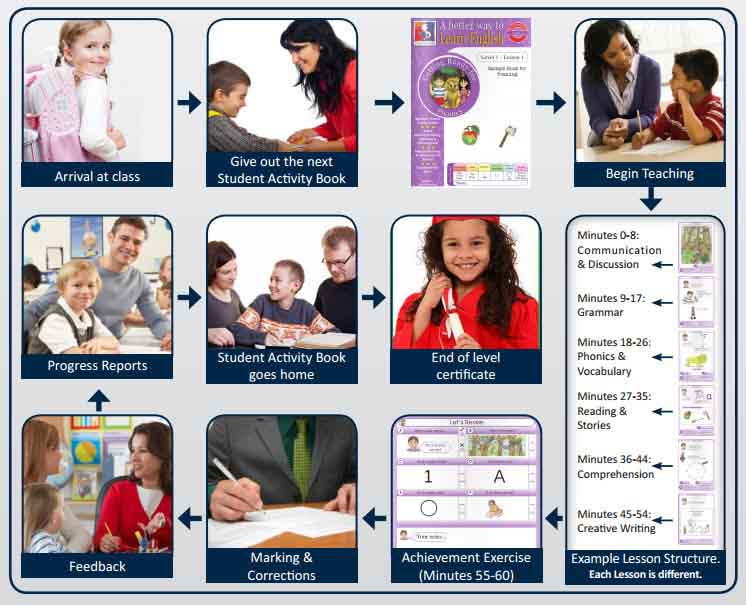
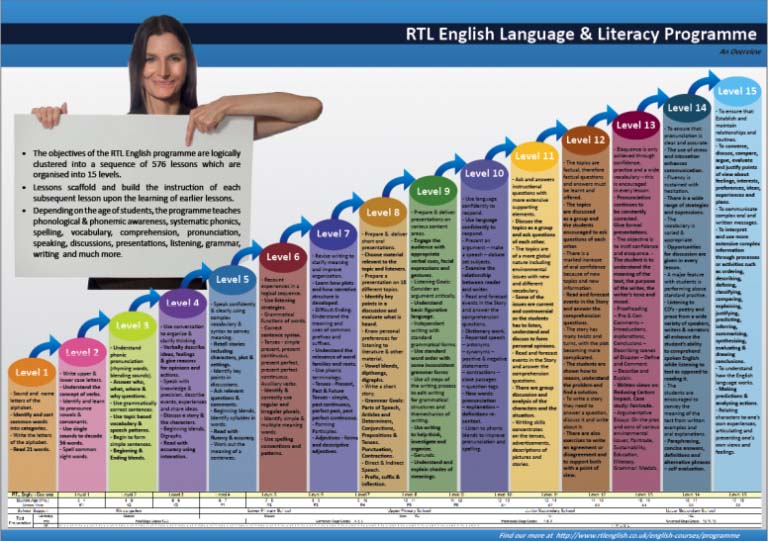
What Will My Child Be Taught?
It depends on your child’s age and their English language ability. To find out what your child will be taught, please click the grey button & then click the book cover that’s closest to your child’s current age → Lesson Workbooks
The RTL English Curriculum teaches all the communicative functions and language forms your child will need to succeed in school, exams and beyond, including:
- Phonemic Awareness
- Alphabetic Principle
- Systematic & Explicit Phonics
- Fluency with Text
- Proficient Grammar Knowledge
- Creative Writing
- Expanded Vocabulary
- Advanced Comprehension, and
- Confident Speaking Skills
The RTL English Curriculum: Kids 3 to 18 Years Old
Whatever your son or daughter’s age or English language ability, there is sure to be an RTL English course (aka ‘level’) that will help your son or daughter learn or improve his or her English. This is because our curriculum provides 15 years of learning for child aged 3 to 18 years old & teaches all the communicative functions and language forms your son or daughter will need to have a richer, more successful educational experience. RTL English will also supplement your child’s learning at his or her school in Albuquerque.
The RTL English Curriculum consists of 15 years (levels) of teaching materials which include 600 workbooks (comprising 4,000 worksheets & 19,000 teaching notes) & saves over 2,000 days of preparation time.Level 1
Kids: 3-4 years old
36 lessons. 36 workbooks. 252 worksheets. 1134 teaching instructions.
Level 2
Kids: 4-5 years old
36 lessons. 36 workbooks. 252 worksheets. 1134 teaching instructions.
Level 3
Kids: 5-6 years old
36 lessons. 36 workbooks. 252 worksheets. 1134 teaching instructions.
Level 4
Kids: 6-7 years old
36 lessons. 36 workbooks. 252 worksheets. 1134 teaching instructions.
Level 5
Kids: 7-8 years old
36 lessons. 36 workbooks. 252 worksheets. 1134 teaching instructions.
Level 6
Kids: 8 -9 years old
36 lessons. 36 workbooks. 252 worksheets. 1134 teaching instructions.
Level 7
Kids: 9-10 years old
36 lessons. 36 workbooks. 252 worksheets. 1134 teaching instructions.
Level 8
Kids: 10-11 years old
36 lessons. 36 workbooks. 252 worksheets. 1134 teaching instructions.
Level 9
Kids: 11-12 years old
36 lessons. 36 workbooks. 252 worksheets. 1134 teaching instructions.
Level 10
Teens: 12-13 years old
36 lessons. 36 workbooks. 252 worksheets. 1134 teaching instructions.
Level 11
Teens: 13-14 years old
36 lessons. 36 workbooks. 252 worksheets. 1134 teaching instructions.
Level 12
Teens: 14-15 years old
36 lessons. 36 workbooks. 252 worksheets. 1134 teaching instructions.
Level 13
Teens: 15-16 years old
36 lessons. 36 workbooks. 252 worksheets. 1134 teaching instructions.
Level 14
Teens: 16-17 years old
36 lessons. 36 workbooks. 252 worksheets. 1134 teaching instructions.
Level 15
Teens: 17-18 years old
8 lessons. 8 workbooks. 56 worksheets. 252 teaching instructions.
Can I See A Lesson Workbook?
There are 600 workbooks like the one below. Lesson 19, Level 1 below suits children between 3 and 4 years old. To see an example of a lesson workbook that is likely to suit your child, please click the grey button & then click the book cover that’s closest to your child’s current age → Lesson Workbooks
What Method Do You Use?
- We teach using a Step-by-Step method. The content of each lesson is determined by an 8-page workbook that’s slightly more challenging than the last in the sequence. Lessons ‘scaffold’ and build upon the learning of the previous lesson. As a result, students advance in small, manageable steps and acquire English language skills that enable them to achieve better results in school, exams & beyond..
- Sequenced instruction is organised into 5 developmentally appropriate stages, 15 levels of increasing difficulty and 600 lessons. Each lesson provides one hour of learning per week and follows a workbook that consists of six worksheets with instructional content and one reinforcement exercise page.:
- Each lesson is accompanied by a workbook follows a similar plan:
- Page 1 :: Communication/ Discussion/ Topic orientated
- Page 2 :: Grammar/ Language
- Page 3 :: Phonics/ Vocabulary
- Page 4 :: Reading (Ongoing Story)
- Page 5 :: Story Comprehension/ Language
- Page 6 :: Grammar/ Language Exercise
- Page 7 :: Achievement Exercise / Assessment
- Depending on your child’s age and their English skills, instruction will typically consist of a variety of activities including speaking, listening, letter-sound correspondence, sight words, guided oral reading, text comprehension, creative writing, grammar and critical thinking.
- You don’t need to prepare anything or create teaching materials for an RTL English lesson. It’s all been done for you. Each page of this workbook contains teaching notes to enable you to guide and lead your child through the learning activities. Once your son or daughter has finished their lesson, record their achievements in the progress report form and then simply print the next workbook in the sequence.
Will My Child Learn Phonics?
- Yes! We teach synthetic & analytical phonics which includes 44 basic phonemes, 22 beginning blends and 15 ending blends.Our students learn and practise phonics throughout our Foundation, Elementary, Intermediate and Upper Intermediate stages. Our Advanced stage uses phonics to teach pronunciation.
- We pay particular attention to blended consonant sounds (that are located at the beginning and end of many words). We teach vowels first and then consonants. As soon as possible we teach children to read. In practice this means after students have learnt 5 vowel sounds and 2 consonants they can read a few words by themselves. Children are also taught how to decode words, so from the very beginning they can see new simple words and know how to read them.
Albuquerque ( AL-bə-kur-kee; Spanish pronunciation: [alβu(ɾ)ˈkeɾke] (![]() listen); Navajo: Beeʼeldííl Dahsinil [pèːʔèltíːl tɑ̀xsɪ̀nɪ̀l]; Eastern Keres: Arawageeki; Jemez: Vakêêke; Zuni: Alo:ke:k'ya; Jicarilla Apache: Gołgéeki'yé), abbreviated as ABQ, is the most populous city in the U.S. state of New Mexico. The city's nicknames are The Duke City and Burque, both of which citation its 1706 founding by Nuevo México supervisor Francisco Cuervo y Valdés as La Villa de Alburquerque. Named in honor of then Viceroy the 10th Duke of Alburquerque, the Villa was an outpost on El Camino Real for the Tiquex and Hispano towns in the area (such as Barelas, Corrales, Isleta Pueblo, Los Ranchos, and Sandia Pueblo). Since the city's founding it has continued to be included on travel and trade routes including Santa Fe Railway (ATSF), Route 66, Interstate 25, Interstate 40, and the Albuquerque International Sunport. The 2019 census-estimated population of the city is 560,513, making Albuquerque the 32nd-most populous city in the United States and the fourth-largest in the Southwest. It is the principal city of the Albuquerque metropolitan area, which has 915,927 residents as of July 2018. The metropolitan population includes Rio Rancho, Bernalillo, Placitas, Zia Pueblo, Los Lunas, Belen, South Valley, Bosque Farms, Jemez Pueblo, Cuba, and ration of Laguna Pueblo. This metro is included in the larger Albuquerque–Santa Fe–Las Vegas comprehensive statistical area (CSA), with a population of 1,171,991 as of 2016. The CSA constitutes the southernmost reduction of the Southern Rocky Mountain Front megalopolis, including extra major Rocky Mountain region cities such as Cheyenne, Wyoming, and Denver, Colorado, with a population of 5,467,633 according to the 2010 United States Census.
listen); Navajo: Beeʼeldííl Dahsinil [pèːʔèltíːl tɑ̀xsɪ̀nɪ̀l]; Eastern Keres: Arawageeki; Jemez: Vakêêke; Zuni: Alo:ke:k'ya; Jicarilla Apache: Gołgéeki'yé), abbreviated as ABQ, is the most populous city in the U.S. state of New Mexico. The city's nicknames are The Duke City and Burque, both of which citation its 1706 founding by Nuevo México supervisor Francisco Cuervo y Valdés as La Villa de Alburquerque. Named in honor of then Viceroy the 10th Duke of Alburquerque, the Villa was an outpost on El Camino Real for the Tiquex and Hispano towns in the area (such as Barelas, Corrales, Isleta Pueblo, Los Ranchos, and Sandia Pueblo). Since the city's founding it has continued to be included on travel and trade routes including Santa Fe Railway (ATSF), Route 66, Interstate 25, Interstate 40, and the Albuquerque International Sunport. The 2019 census-estimated population of the city is 560,513, making Albuquerque the 32nd-most populous city in the United States and the fourth-largest in the Southwest. It is the principal city of the Albuquerque metropolitan area, which has 915,927 residents as of July 2018. The metropolitan population includes Rio Rancho, Bernalillo, Placitas, Zia Pueblo, Los Lunas, Belen, South Valley, Bosque Farms, Jemez Pueblo, Cuba, and ration of Laguna Pueblo. This metro is included in the larger Albuquerque–Santa Fe–Las Vegas comprehensive statistical area (CSA), with a population of 1,171,991 as of 2016. The CSA constitutes the southernmost reduction of the Southern Rocky Mountain Front megalopolis, including extra major Rocky Mountain region cities such as Cheyenne, Wyoming, and Denver, Colorado, with a population of 5,467,633 according to the 2010 United States Census.
Albuquerque serves as the county chair of Bernalillo County, and is in north-central New Mexico. The Sandia Mountains direct along the eastern side of Albuquerque, and the Rio Grande flows north to south through its center, while the West Mesa and Petroglyph National Monument make up the western allowance of the city. Albuquerque has one of the highest elevations of any major city in the U.S., ranging from 4,900 feet (1,490 m) above sea level near the Rio Grande to over 6,700 feet (1,950 m) in the foothill areas of Sandia Heights and Glenwood Hills. The civic apex is found in an undeveloped Place within the Albuquerque Open Space; there, the terrain rises to an height above sea level of approximately 6880+ feet (2,097 m).
The economy of Albuquerque centers upon science, medicine, technology, commerce, education, entertainment, and culture outlets. The city is home to Kirtland Air Force Base, Sandia National Laboratories, Lovelace Respiratory Research Institute, Presbyterian Health Services, and both the University of New Mexico and Central New Mexico Community College have their main campuses in the city. Albuquerque is the middle of the New Mexico Technology Corridor, a amalgamation of high-tech institutions, including the metropolitan Place being the location of Intel's Fab 11X In Rio Rancho and a Facebook Data Center in Los Lunas, Albuquerque was furthermore the founding location of MITS and Microsoft. Film studios have a major presence in the allow in of New Mexico, for example Netflix has a main production hub at Albuquerque Studios. There are numerous shopping centers and malls within the city, including ABQ Uptown, Coronado, Cottonwood, Nob Hill, and Winrock. The city is the location of a horse racing track and casino called The Downs Casino and Racetrack, and the Pueblos surrounding the city feature resort casinos, including Sandia Resort, Santa Ana Star, Isleta Resort, and Laguna Pueblo's Route 66 Resort.
The city hosts the International Balloon Fiesta, the world's largest growth of hot-air balloons, taking place all October at a venue referred to as Balloon Fiesta Park, with its 47-acre opening field. Another large venue is Expo New Mexico where new annual goings-on are held, such as North America's largest pow wow at the Gathering of Nations, as well as the New Mexico State Fair. While supplementary major venues throughout the metropolitan area include the National Hispanic Cultural Center, the University of New Mexico's Popejoy Hall, Santa Ana Star Center, and Isleta Amphitheater. Old Town Albuquerque's Plaza, Hotel, and San Felipe de Neri Church hosts conventional fiestas and endeavors such as weddings, also near Old Town are the New Mexico Museum of Natural History and Science, Albuquerque Museum of Art and History, Indian Pueblo Cultural Center, Explora, and Albuquerque Biological Park. Located in Downtown Albuquerque are historic theaters such as the KiMo Theater, and near the Civic Plaza is the Al Hurricane Pavilion and Albuquerque Convention Center as soon as its Kiva Auditorium. Due to its population size, the metropolitan area regularly receives most national and international music concerts, Broadway shows, and further large traveling events, as skillfully as New Mexico music, and further local music performances.
Likewise, due to the metropolitan size, it is house to a diverse restaurant scene from various global cuisines, and the state's clear New Mexican cuisine. Being the focus of the Middle Rio Grande Conservancy District gives an agricultural contrast, along acequias, to the on the other hand heavily urban tone of the city. Crops such as New Mexico chile are grown along every Rio Grande, the red or green chile pepper is a staple of the aforementioned New Mexican cuisine. The Albuquerque metro is a major contributor of the Middle Rio Grande Valley AVA subsequently New Mexico wine produced at several vineyards, it is also home to several New Mexican breweries. The river as a consequence provides trade permission with the Mesilla Valley (containing Las Cruces, New Mexico and El Paso, Texas) region to the south, with its Mesilla Valley AVA and the next-door Hatch Valley which is skillfully known for its New Mexico chile peppers.

Academic References
- The Cognitive Foundations of Learning to Read: A FrameWork Sebastian Wren
- The relatonship of phonemic awareness to reading acquisiton: more consequence than preconditon but still important. Wimmer H, Landerl K, Linortner R, Hummer P. University of Salzburg, Austria.
- NAEP 1998 Reading Report Card for the Nation and the States March 1999 Authors: Patricia L. Donahue, Kris n E. Voelkl, Jay R. Campbell, and John Mazzeo
- National Institute of Child Health and Human Development. (2000). Report of the National Reading Panel. Teaching children to read: An evidence-based assessment of the scientific research literature on reading and its implications for reading instruction (NIH Publica on No. 00-4769). Washington, DC: U.S. Government Prin ng Office.
- Wikipedia: http://en.wikipedia.org/wiki/Functional_illiteracy
- J Learn Disabil. 2009 Sep-Oct;42(5):392-402. Epub 2009 Jun 19. Why elementary teachers might be inadequately prepared to teach reading. Joshi RM, Binks E, Hougen M, Dahlgren ME, Ocker-Dean E, Smith DL.
- Australia Government Department of Educa on, Science and Training: htt p://www.dest.gov.au/archive/schools/literacy&numeracy/charts.html
- CBC News: Canada’s Shame – h p://www.cbc.ca/news/background/educa on/canada-shame.html
- The Timing and Quality of Early Experiences Combine to Shape Brain Architecture Center on the Developing Child, Harvard University
- Vocabulary Development and Instruc on: A Prerequisite for School Learning Andrew Biemiller, University of Toronto iii. Early reading acquisiton and its relation to reading experience and ability 10 years later. Cunningham AE, Stanovich KE.
- Double Jeopardy How Third-Grade Reading Skills and Poverty Influence High School Gradua on Donald J. Hernandez, Hunter College and the Graduate Center
- What Reading Does for the Mind ANNE E. CUNNINGHAM and KEITH E. STANOVICH

